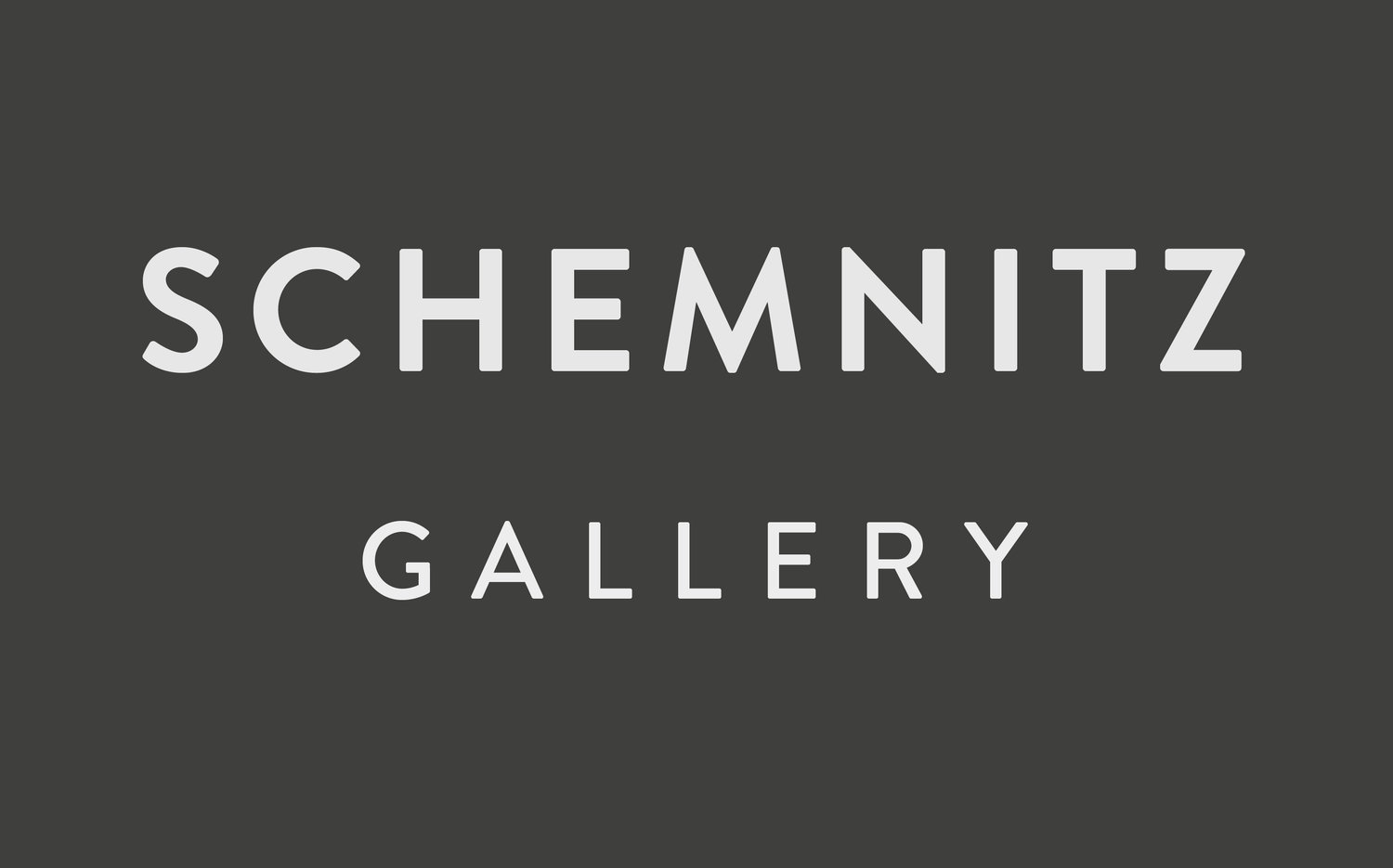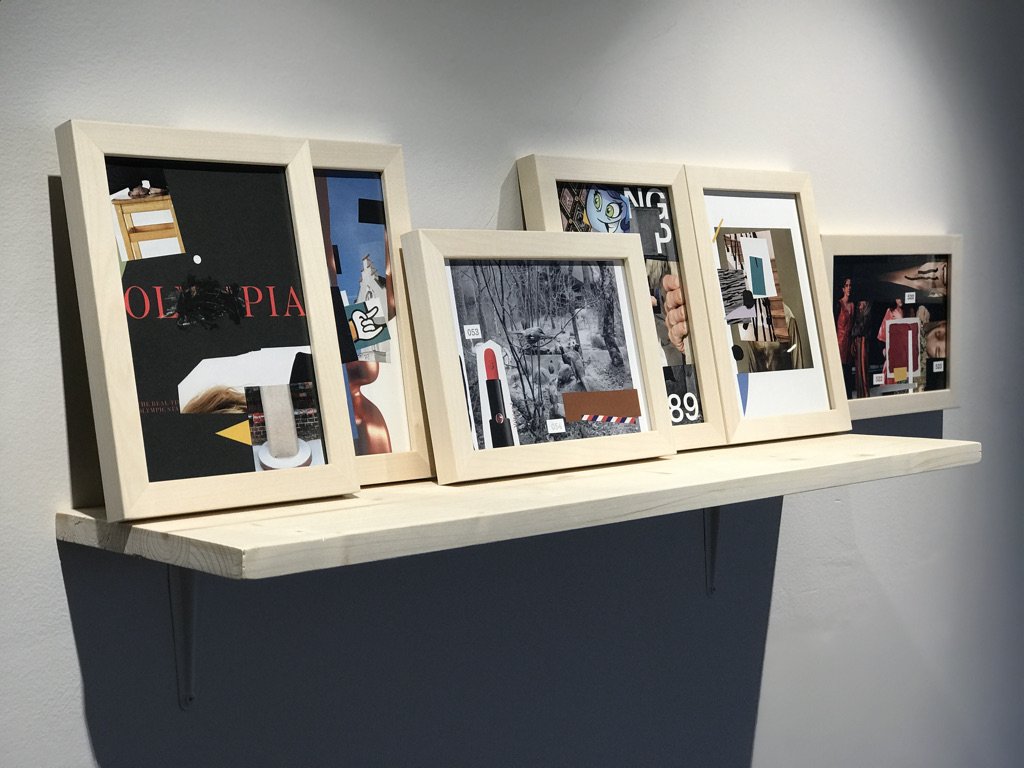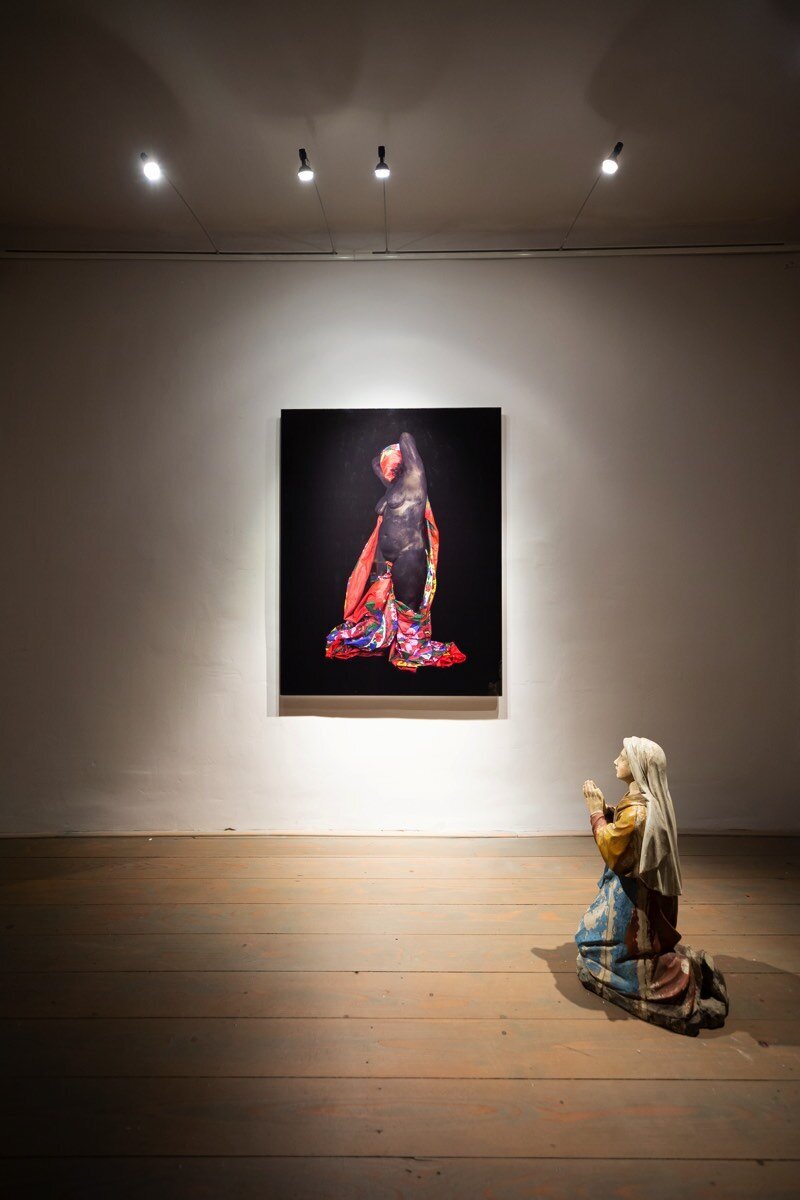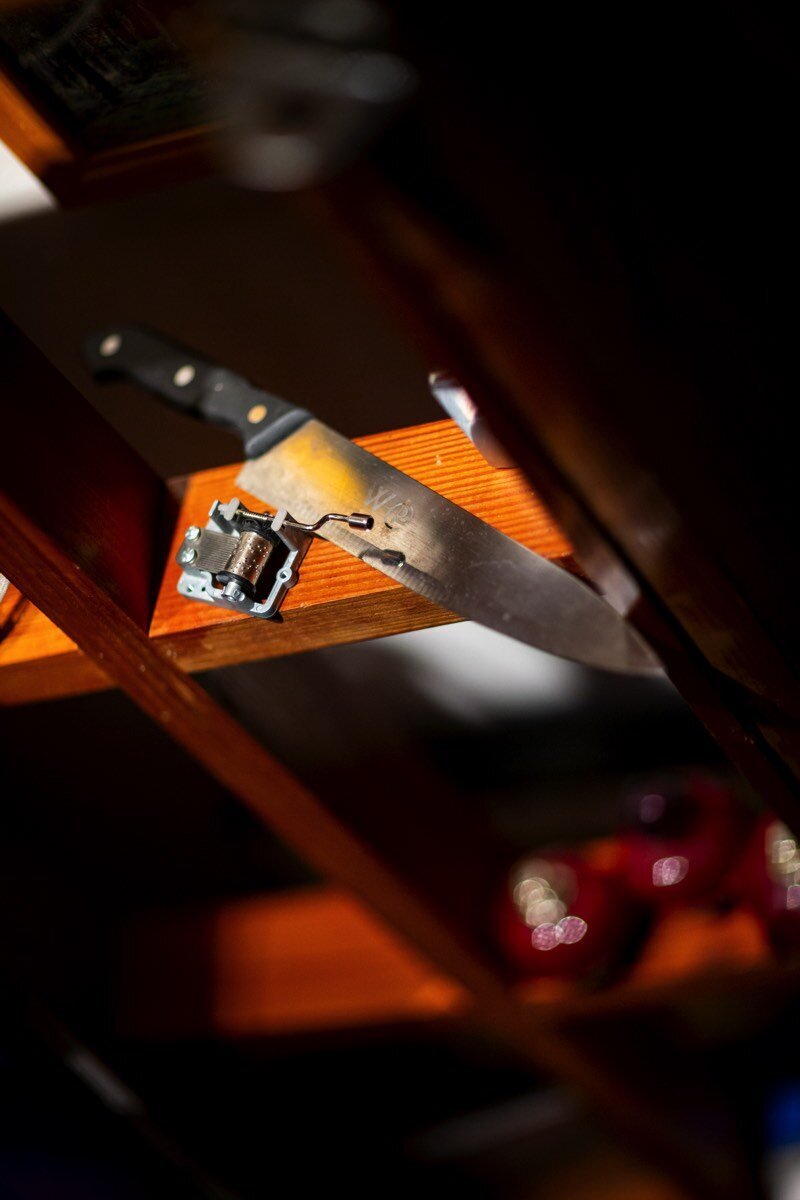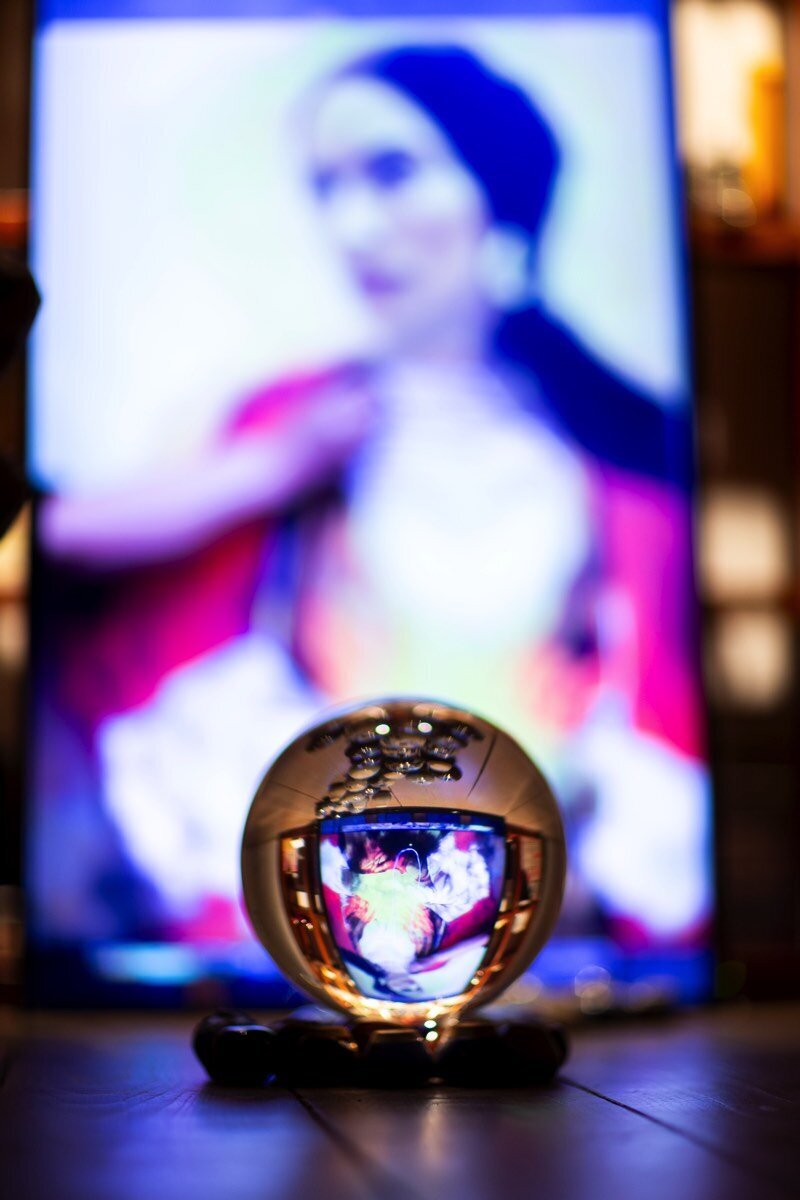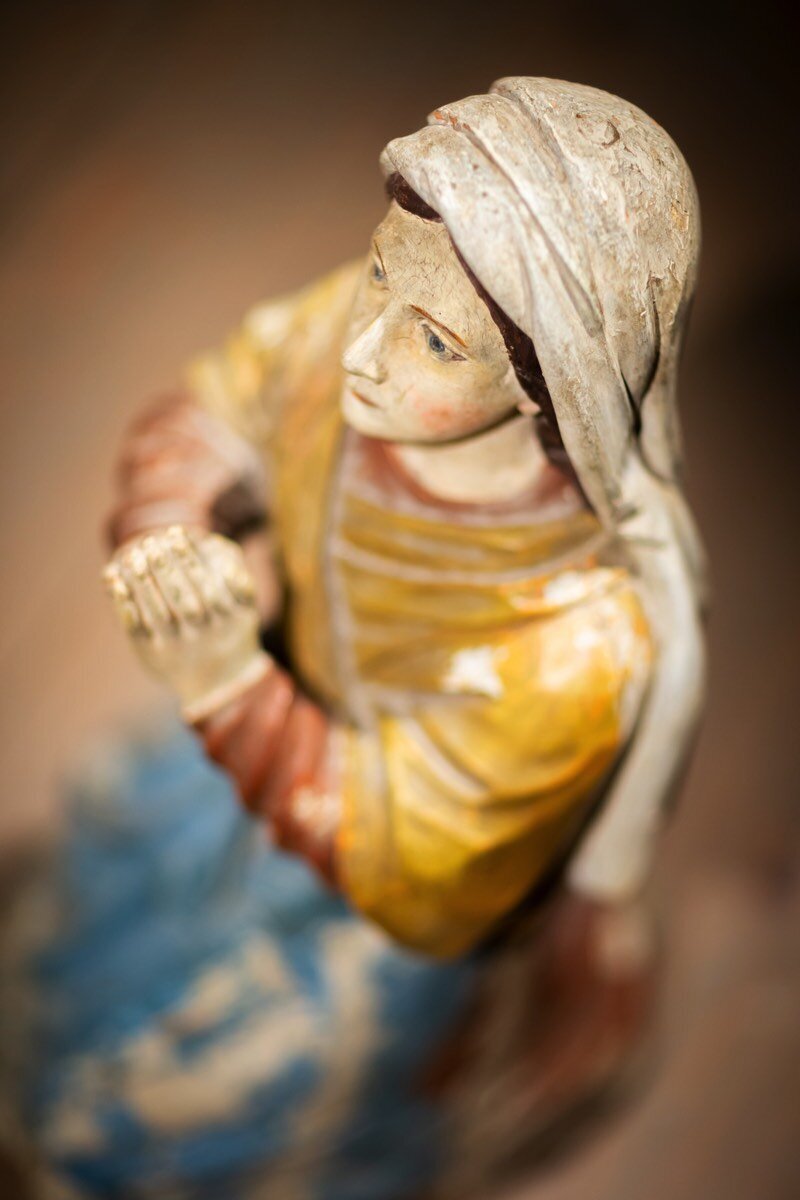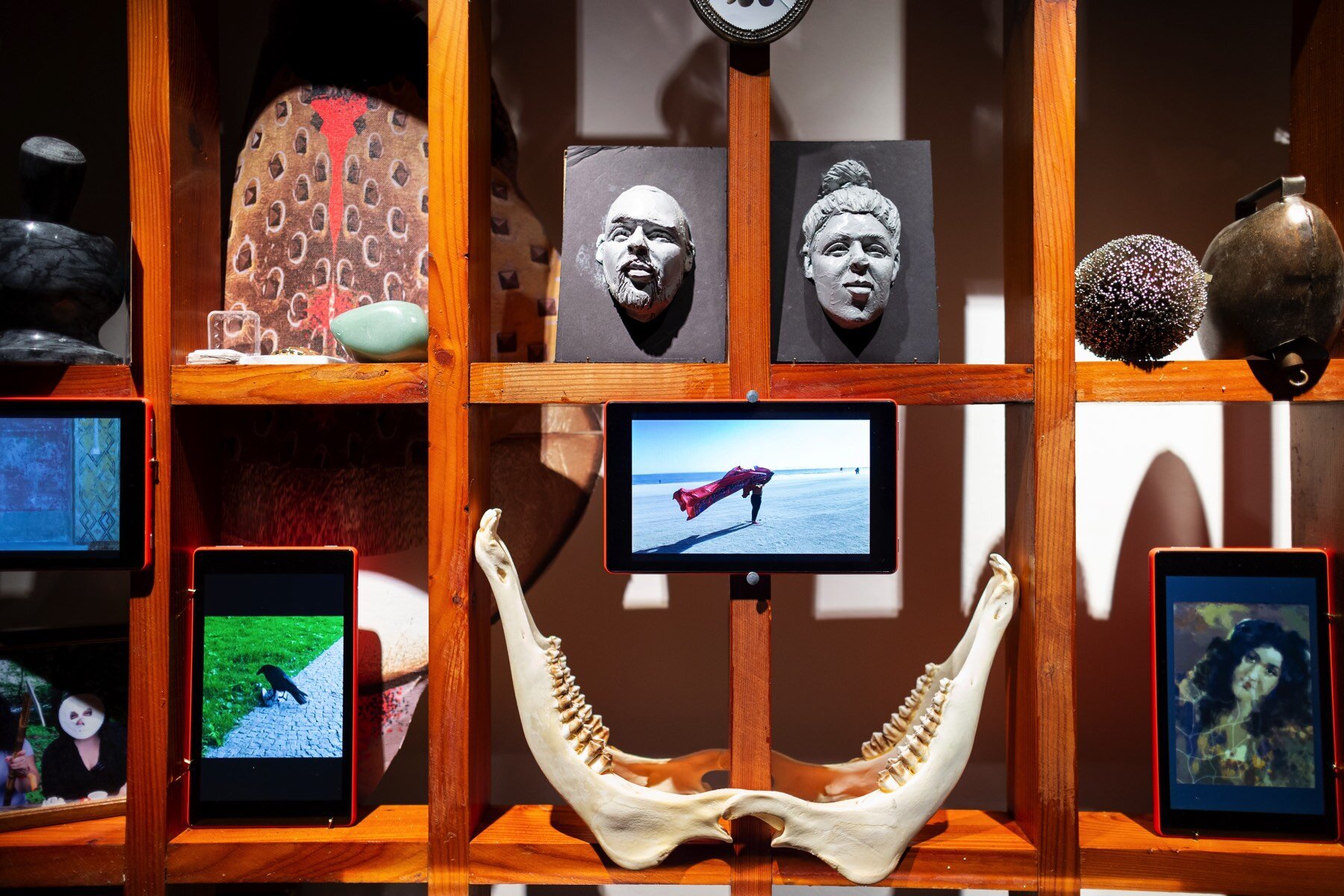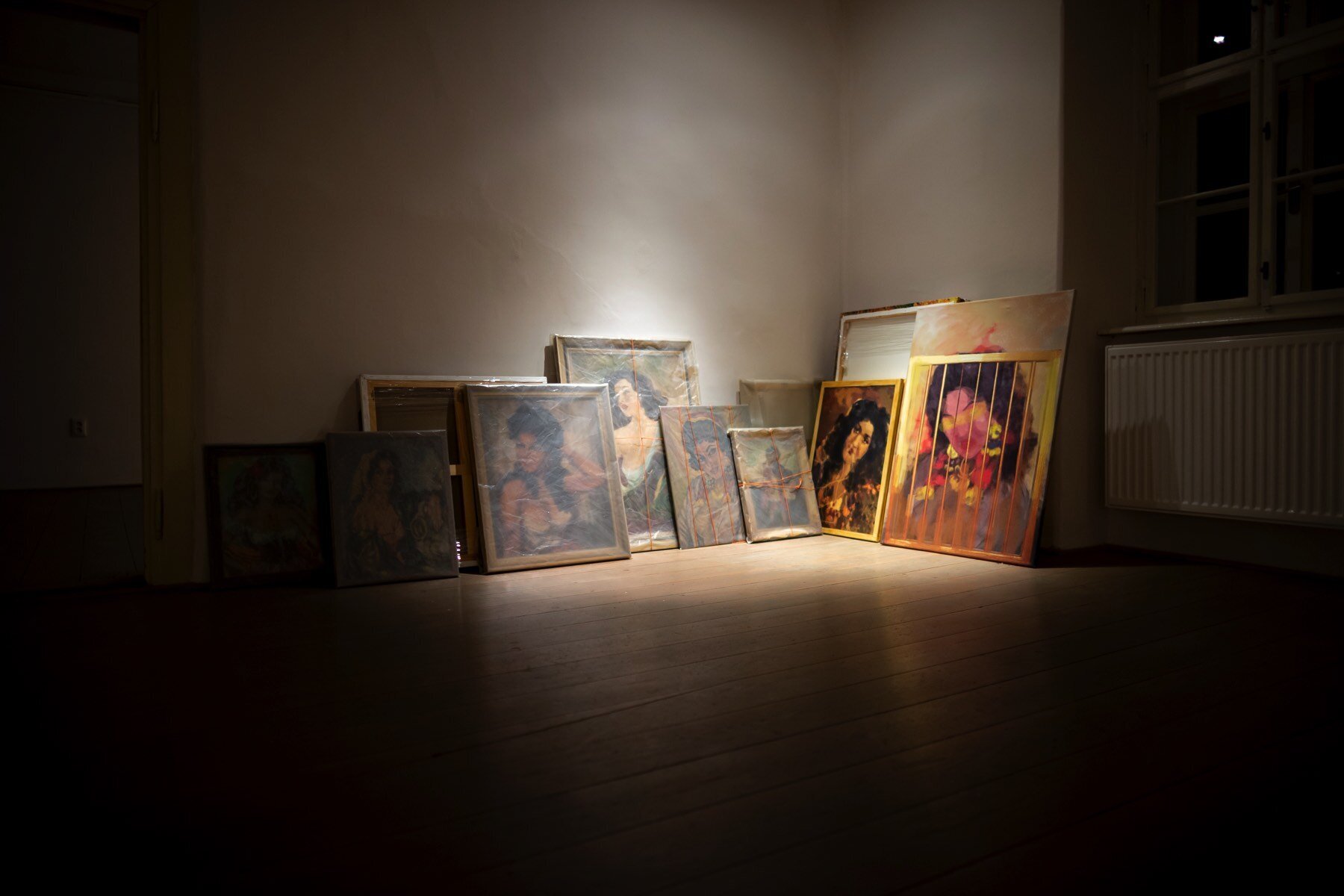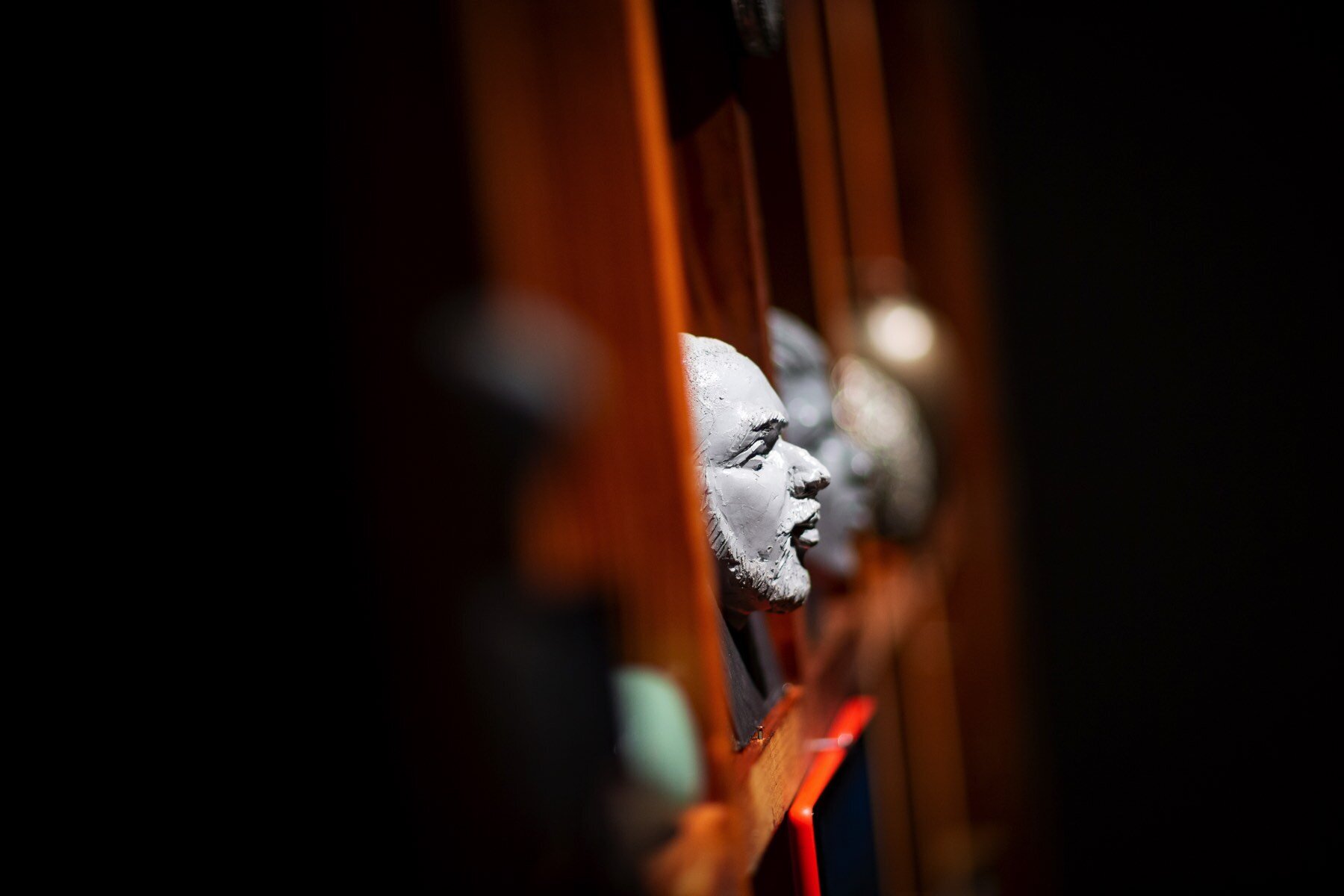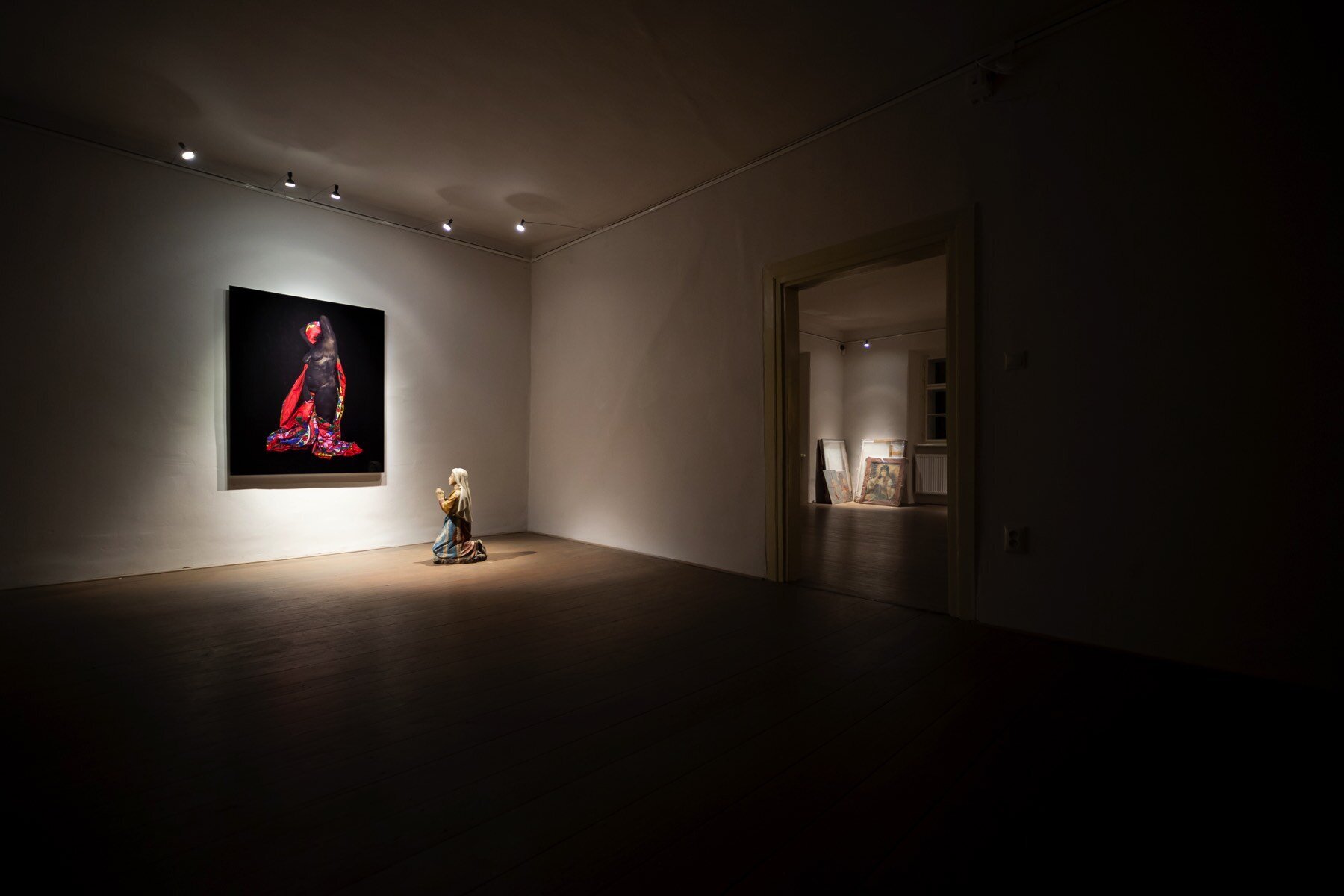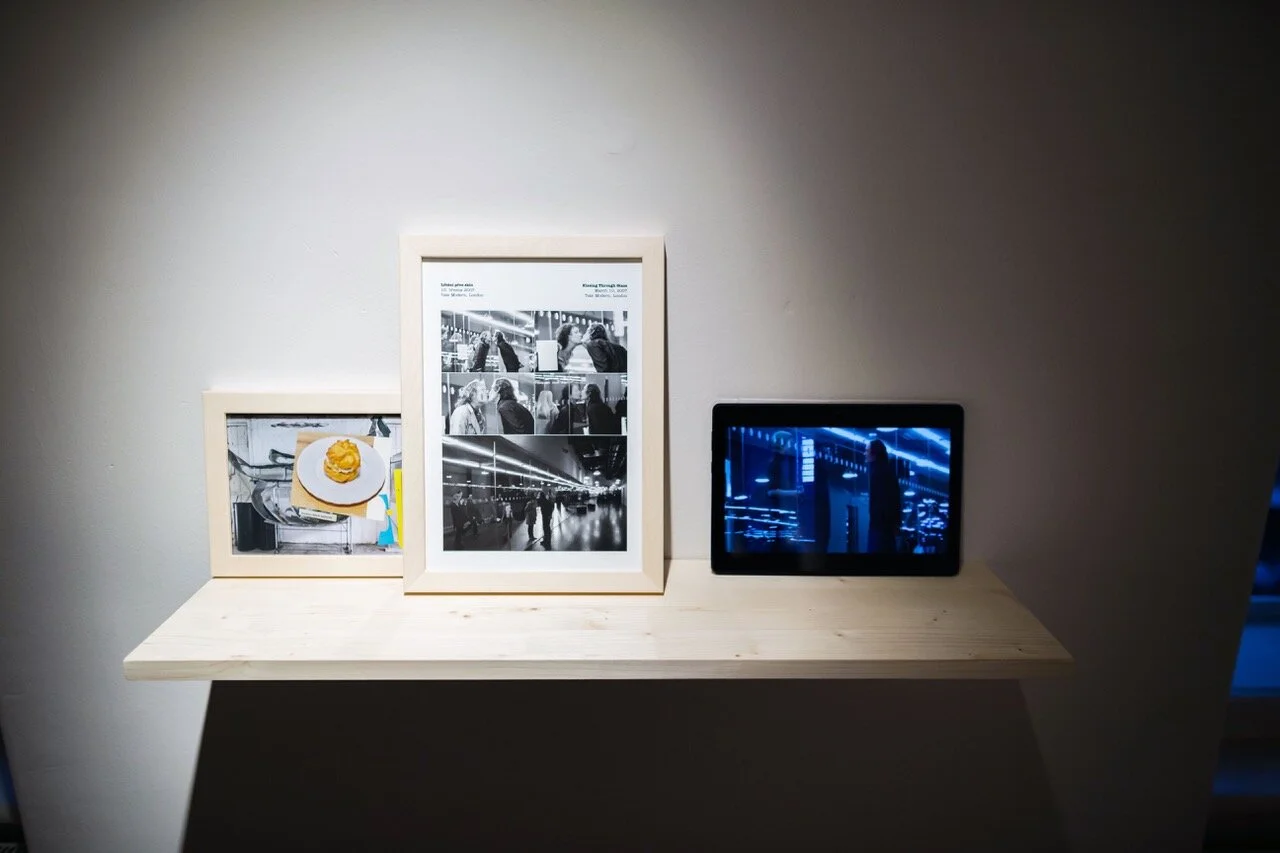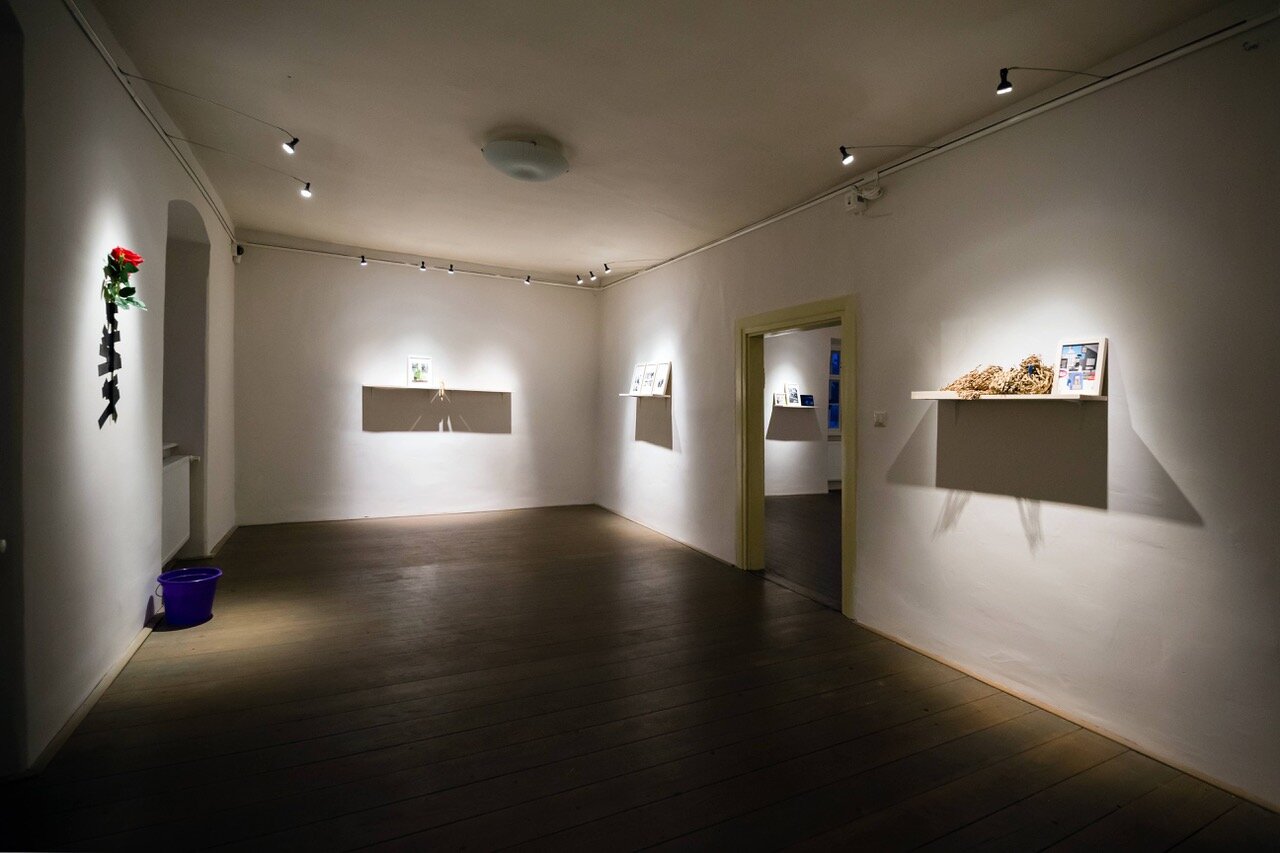VÝSTAVY | EXHIBITIONS 2020
Matúš Lányi & Viera Zubalová | Digitálny liturgický obrad
PETER DECHEŤ, MARTIN JOMBÍK, ADAM ŠARVAIC, DOMINIKA KOLAČKOVSKÁ, MIROSLAV SANDANUS, ĽUBOMÍR SLOVINSKÝ & MIRIAM HRÍŇOVÁ | Ohnisková vzdialenosť
Rastislav Podoba | Landscan
OSKAR FELBER, MARGARÉTA PETRŽALOVÁ & KRYŠTOF STREJC | Young & wild
Jiří Kovanda | Co k čemu? Kde s kým?
Emília Rigová | Kale bala parno muj
Kale bala parno muj | biela huba čierne vlasy
Emília Rigová
Kurátorka: Petra Hanáková
Vernisáž: 31. 10. 2020, 19:00 hod
Trvanie výstavy: 1. 11. – 30. 12. 2020
Inštalácia Emílie Rigovej, vymyslená na telo a priestorové dispozície Galérie Schemnitz, je esenciou toho, čo umelkyňu v posledných rokoch najviac zamestnáva: jej vlastná (rómska) identita. Čo to znamená pre ňu samu; čo to znamená na Slovensku; čo to znamená na scéne umenia i na trhu s umením? Celý tento problémový komplex by sa dal trochu ironicky označiť aj spojením Identity Trouble – trampoty s identitou.
Ale keďže Rigová je Rigová, je to sebakritická a navyše feministická umelkyňa, je pre ňu (a tým aj pre nás!) jej „kríza“ ideálnou príležitosťou k sebapoznaniu.
Svoju inštaláciu s názvom Kale bala parno muj (Biela huba, čierne vlasy) umelkyňa delí do troch celkov, troch prostredí s vlastnou (mediálnou) logikou i osobitou atmosférou. Každý priestor je síce jedinečným prostredím, spolu však tvoria jeden dostredivý koncept. Ten v istom zmysle, hoci je celkom novým dielom, v sebe zároveň nesie aj črty retrospektívy – autorského obzretia sa späť. Na seba samu i vlastnú tvorbu posledných rokov.
Absolventka Akadémie umení v Banskej Bystrici a jedna z posledných laureátok Ceny Oskára Čepana Emília Rigová (1980) je v pravom slova zmysle post-mediálnou umelkyňou. Pracuje v tom umeleckom médiu, ktoré jej v danej chvíli najviac vyhovuje. Tento dynamický pohyb naprieč médiami sprostredkuje aj výstava v Schemnitz Gallery. Ako svoje rómske alter ego Bari Raklori sa Emília najčastejšie vyjadruje maľbou – digitálne mastrovaným autoportrétom. V seba-inscenujúcich fotografiách či videách sa voči svojej romacite kriticky vymedzuje. Nie je to však rómstvo, ktorým nás každodenne saturujú médiá – rómstvo ako sociálna (a najnovšie už aj epidemiologická) hrozba. Na rozdiel od nerómskych umelcov/umelkýň, v ktorých tvorbe sa rómska téma najčastejšie viaže na chudobu, sociálne problémy a vylúčené komunity, hoc aj s úmyslom pomôcť im, Rigová si z pomyselného rómskeho balíčka vyberá iné, skôr pozitívne obrazy a hodnoty: bohatosť duchovnej a materiálovej tradície, synkretizmus náboženských predstáv, „neznáme“ dejiny... Emília Rigová si je vedomá svojej exotickej pozície na domácej výtvarnej scéne. Profit, ktorý z nej má, ju zároveň teší i konštruktívne znepokojuje. Nenechá sa „zavrieť do vitrínky“. Vzdoruje škatuľkám, respektíve: sama si ich – ako svoja vlastná kurátorka – príležitostne otvára, a sa v nich – v rámci svojich situačných identít – neustále preskupuje.
Komentovaná prehliadka výstavy KAle bala parno muj
Účinkujú: Emília Rigová a Petra Hanáková
ARTIST: EMÍLIA RIGOVÁ
KALE BALA PARNO MUJ | WHITE MOUTH BLACK HAIR
Curator: Petra Hanáková
Non-public opening of exhibition: 31 Oct 2020, 7 pm
Duration of exhibition: 1 Nov – 30 Dec 2020
Emília Rigová (1980), graduate of the Art Academy in Banská Bystrica and one of the recent laureates of the Oskár Čepan Prize, is, in the true sense of the word, a po-media artist. She works with media she finds the most suitable at the moment. Such a dynamic movement across media is offered by the exhibition in Schemnitz Gallery, too.
As her Roma alter ego, Bari Raklori, Emília expresses herself mostly through painting – digitally mastered self-portrait. In self-staged photographs or videos, she positions herself critically toward her Roma origin. However, the Roma world she presents is not the one with which we are flooded by the media on a daily basis – the Roma world as a social (and nowadays also epidemiological) danger. Unlike non-Roma artists who, although with an intention to help, mostly present Roma related topics as bound to poverty, social problems and excluded communities, Rigová prefers to select positive images and values from the imaginary Roma package: richness of the spiritual and material traditions, syncretism of religious notions, “unknown” history… Emília Rigová is aware of her exotic position on the domestic art scene. The profit she has from this position makes her both pleased and constructively disturbed. She does not permit herself to be “locked up in a showcase”. She resists boxes; or, as her own curator, she occasionally opens them and – reflecting her situational identities – “regroups” herself within the boxes. Emília Rigová’s installation, tailor-made to the spatial dispositions of Schemnitz Gallery, is an essence of what the artist has been occupied with over the last few years: her own (Roma) identity. What does it mean to her; what does it mean in Slovakia; what does it mean on the art scene and art market? This complex issue could be labelled, somewhat ironically, with the collocation Identity Trouble. But, since Rigová is Rigová, a self-critical and, moreover, feminist artist, her “crisis” is an ideal opportunity for her (and thus for us too!) to seek self-knowledge.
Emília (Milka) has divided her installation, entitled Kale bala parno muj (White mouth, black hair), into three units, three environments, each having both its own (media) logic and unique atmosphere. Each space is a unique environment, but together they form one centripetal concept. Although being a completely new work, the concept, in a certain sense, bears signs of retrospectivity – the artist’s looking back at herself and her artwork of the last few years. Map of the artworks: oltáRIG (From “oltárik” - “small altar”) In its nature, the first room is the “densest”; it is rather like a museum or chamber of curiosities of Emília Rigová – of her identity, or perhaps even a “Rigová institute”. However, some other concepts of expanded imagery or emotion-charged image fields could be applicable here: the Warburg’s Bilderatlas, mood walls in teenagers’ bedrooms, Pinterest walls, or detectives’ pinup boards, so common in recent crime stories and which, symptomatic of current times, the art historian W. J. T. Mitchell enjoys studying so much. Simply put, what we see here is Emília’s, Milka’s, compacted image-semantic world – what she likes, what likes her: presents from friends, fetishes, souvenirs and talismans, voodoo (?), but also miniatures, fragments or relics of her own artworks, for example, a unique video-anthology… this all laid out, for both the view from a distance and the camera lens, into a certain (mental?) grid of a large set of shelves. In fact, the installation is a self-portrait. On the one hand a very intimate one, on the other a strictly edited one. Rigová has always been strong in (self)staging, and this altar of her identity confirms that. It is an invitation to the adventure of reading, or even to a certain kind of “interpretive cannibalism”. GODDESS/IDOL The second room is considerably more minimalistic. It is hard to comprehend what is happening here, one of the reasons being that, in arranging two art objects, Rigová purposefully stretches the arch of ambivalence to make it as large as possible. Stretches and/but zooms it in! A naked self-portrait is hanging on the wall. Not Roma enough, the artist coloured herself more black and wrapped part of her body in an ethno-scarf; so, clearly, she has self-colonised herself. At the same time: it is not an ideal body. In spite of that, it presents itself with confidence. In other words, it is a feminist self-portrait. In front of this nude (a quasi-idol or pagan Goddess), a sculpture of a praying young woman is installed (perhaps Bernadette from a scattered Lourdes sculpture). This woman-woman relationship is clearly blasphemous, with an intention – I suppose – to induce (and perhaps to ironize, too) the reputed unconventionality of Roma religious notions. However, definitely more readings are invited here… DEPO/AUCTION The last part of the exhibition reminds us of a depository room (a kind of private museum of Roma imagery), a storage, a “consignment” room… anyway, a background space of an institution that “consorts” with pictures. The artist, I suppose, uses the medium of installation to evoke a sense of fatigue with both artistic operation and self-operation, as she has perceived and experienced it in the last few years. It is perhaps a vanitas – an account of the vanity and velocity of pictures’ circulation, of their interchangeability. Or, is it an ecological (?), a bit of a Covid, challenge to slow down our activity and “flatten the curve” of the art performance acceleration. A bit of morality for self-reflection here.
Co k čemu? Kde s kým?
Jiří Kovanda
Kurátor: Michal Koleček
Vernisáž: 29. 8. 2020, 19:00 hod
Trvanie výstavy: 30. 8. – 25. 10. 2020
Výstava Jiřího Kovandu (ČR) v Galérii Schemnitz v Banskej Štiavnici nadväzuje na dlhodobú stratégiu site-specific intervencií tohto autora, v ktorých subtílnym, ale výsostne estetickým spôsobom vždy citlivo reaguje na architektonické, ako aj obsahové usporiadanie výstavných priestorov. Tieto intervencie však Jiří Kovanda chápe v širších súvislostiach a vkladá do ich kontextu aj významy spojené s miestom a komunitou, ktorých súčasťou sú inštitúcie, pre ktoré svoje projekty pripravuje.
Koncepcia aktuálnej výstavy Jiřího Kovandu v Galérii Schemnitz vychádza z umelcovho dlhodobého záujmu o skúmanie možností a limitov vzájomnej individuálnej, ako aj spoločenskej komunikácie. Všíma si jej aktuálne premeny pod vplyvom podvedomých i štátom organizovaných obmedzení počas pandémie koronavírusu a toho, ako ľudia túto pandémiu prežívajú. Autor v rámci takto stanoveného tematického poľa vstupuje do priestoru galérie, aby ho zabýval prostredníctvom série mikro-dialógov vyrastajúcich z hľadania súvislostí medzi jeho staršími dielami a najnovšími kolážami, ktoré tohto roku vznikali ako vizuálny denník v čase lock-downu, v izolácii.
Otázky formulované v názve výstavy reprezentujú základné princípy prístupu, ktoré si Jiří Kovanda zvolil pre spájanie diel do dvojíc. Tieto diela sú často od seba časovo vzdialené aj desiatky rokov a boli tiež vytvorené v odlišných kontextoch. Polička umiestnená na každej, pre expozíciu diela vhodnej stene galérie „hostí“ teda vždy jedno staršie autorovo dielo, jeho remake či dokumentáciu. Dielo je vybrané s dôrazom na témy, ktoré sú previazané s odhaľovaním či prekonávaním rôznych typov vnútorných alebo vonkajších limitov a obmedzení v procese komunikácie s miestom, komunitou a divákom. K tomuto „historickému“ dielu potom Jiří Kovanda asociačne priraďuje jednu z nových koláží, ktoré vytvoril v priebehu koronavírusovej klauzúry, pričom si ako základnú myšlienkovú i materiálovú inšpiráciu privlastnil rôznorodé pozvánky na výstavy, v tomto období plánované, zrušené, prerušené či presunuté na iné termíny.
Výstava CO K ČEMU? KDE S KÝM? predstavuje divákom otázky vyplývajúce z vnímania krehkých línií v logike dlhodobého autorského konceptu Jiřího Kovandu. Tieto línie sú prezentované formou dočasného rozhovoru medzi konkrétnymi, zdanlivo vzdialenými a nesúvisiacimi umeleckými dielami autora. Výstava zároveň akcentuje, pre súčasnú spoločnosť výsostne aktuálnu, metaforicky exponovanú, problematiku nového nazerania na zodpovednosť a slobodu nášho pohybu vo verejnom priestore.
---
Jiří Kovanda (1953) je bezpochyby jedným z najvýznamnejších a najvplyvnejších súčasných českých umelcov. Jeho tvorba je charakteristická príklonom k nenápadným fyzickým intervenciám či subtílnym objektovým realizáciám, ktoré vyrastajú z tradície neskoro modernistického konceptualizmu originálnym spôsobom transformovaného do postmoderného gesta v jeho špecifickej stredoeurópskej podobe.
Jiří Kovanda je tiež známym a často prezentovaným umelcom na medzinárodnej umeleckej scéne. Predovšetkým po roku 2000 bol Jiří Kovanda pozývaný na viaceré kľúčové umelecké prehliadky. Môžeme spomenúť napríklad Kasselskú Documentu 12 v roku 2007, Sao Paulo Biennial v roku 2012 či Istanbul Biennial v roku 2013. Bol tiež zaradený do zbierok prestížnych inštitúcií – napríklad Centre Pompidou v Paríži alebo Museum of Modern Art v New Yorku.
Michal Koleček
Title of exhibition: WHAT TO WHAT? WHERE WITH WHO?
Curator: Michal Koleček
Opening ceremony: 29 Aug 2020, 7 pm
Duration of exhibition: 30 Aug – 25 Oct 2020
Jiří Kovanda’s (CR) exhibition in Schemnitz Gallery, Banská Štiavnica, is a continuation of the artist’s long-term strategy of site-specific interventions, in which he uses subtle but highly aesthetic ways to respond to both the architectural and the content arrangement of exhibition premises. Jiří Kovanda, however, perceives these interventions in a wider context, also including in them meanings related to the broader location and community, part of which are the institutions in which he presents his projects.
The concept of the current exhibition in Schemnitz Gallery reflects Jiří Kovanda’s ongoing interest in examining the possibilities but also the limits of human communication, both individual and social. He is observing its current transformation under the influence of (i) restrictions (sub-conscious but also state-organised) during the current coronavirus pandemic, and (ii) other ways people experience this pandemic. Within this defined thematic field, the artist enters the Gallery space to populate it with a series of micro-dialogues emerging from a search of contextual connections between his earlier works and the newest collages, which were created as a visual journal in the course of the lock-down, in isolation.
The questions contained in the exhibition’s title represent the basic principles of the approach Jiří Kovanda has chosen for linking his works in pairs. These works are often decades distant from each other, and were also created in various contexts. Therefore, a shelf, located on each suitable wall of the Gallery, always “hosts” one older Kovanda work, its re-make, or documentation. The selection of these works has been made with an emphasis on topics tied to revealing or overcoming various types of internal or external limits and restrictions in the process of communication with the site, the community and the viewer. This “historical” piece of work is assigned a related collage, which Jiří Kovanda created during the coronavirus closure. For this, he has appropriated, as the basic conceptual and material inspiration, a variety of invitations to exhibitions planned, cancelled, suspended or transferred to other dates during the lock-down.
The exhibition WHAT TO WHAT? WHERE WITH WHO? introduces questions resulting from the perception of the fragile lines of the internal logic of the concepts upon which Jiří Kovanda has based his creative approach for many years. These lines are presented in the form of temporary dialogue between individual, seemingly distant, and unrelated artworks. The exhibition also accentuates a highly up-to-date, metaphorically exposed, issue relating to the new perception of responsibility for and freedom in the way we move in public space.
---
Jiří Kovanda (1953) is, undoubtedly, one of the most important and influential contemporary Czech artists. His works are characterised by an inclination to inconspicuous physical interventions or subtle object installations, which are rooted in the tradition of late modernist conceptualism, originally transformed into a postmodernist gesture in its specific central-European expression.
Jiří Kovanda is also a well-known and often presented on the international art scene Since 2000 especially, Jiří Kovanda has been invited to participate in a number of key art shows, for example, the documenta 12 at Kassel, Germany; the Sao Paulo Biennial in 2012; and the Istanbul Biennial in 2013. He has also been included in the art collections of prestigious institutions, for example, the Centre Pompidou in Paris and the Museum of Modern Art in New York.
Michal Koleček
YOUNG & WILD
OSKAR FELBER (SK) MARGARÉTA PETRŽALOVÁ (SK) KRYŠTOF STREJC (CZ)
Vernisáž: 26.6.2020 o 19:00 hod
Projekt Young & Wild reaguje na aktuálne tendencie a prejavy v súčasnom maliarstve a zároveň voľne tematizuje ľahkosť mladého bytia. Vizuálna esej rozpráva o nespútanej mladosti (duchom, nie vekom), ktorá je signifikantná introspektívnym prežívaním, organickým prístupom k životu a tvorbe a bezhraničnou otvorenosťou voči experimentovaniu a skúšaniu nových vecí. Koncepcia výstavy spojila autorku a autorov najmladšej generácie česko-slovenskej výtvarnej scény, ktorí sa venujú primárne tradičnej maľbe a občasným presahom v intenciách expandovanej maľby, tvorbe priestorových objektov a kresbe. Vystavujúcu trojicu okrem vzťahu k maliarskemu uvažovaniu spája aj generačná príbuznosť (všetci sú minuloroční absolventi rozličných vysokých škôl) a formou nezaťažený vizuálny eklektizmus prekvitajúci od začiatku ich aktívnej tvorby.
Vystavené diela spája záujem o telesnosť, prostredníctvom ktorej autorka a autori rozvíjajú témy späté so zobrazovaním, dešifrovaním a skúmaním identity a postavenia jednotlivcov (i seba) v súčasnej spoločnosti. K figuratívnemu zobrazovaniu využívajú rôznorodé formálne a ideové prístupy. Na výstave sa tak striedajú figurálne motívy so symbolizujúcim charakterom a dôrazom na sebareflexiu (Kryštof Strejc) s telami, ktoré nič neskrývajú – sú zachytené v banálnych momentoch a neprikrášlených záchvevoch reality so silným emocionálnym podfarbením (Margaréta Petržalová). Zobrazovanie telesnosti vedie až k jej absolútnej absencii a zostáva prítomná len použitou farebnosťou pripomínajúcim farbu kože, gestickou expresivitou a motívmi inšpirovanými tetovaniami a hororovou kultúrou (Oskar Felber). Hlavnou inšpiráciou vystavujúcich sú témy vychádzajúce z najbližšieho okolia a vlastného životného štýlu. Prirodzený záujem o banalitu bežných dní, mystifikácií výjavov, ironizovaní (umeleckej) scény či hlboko zakorenený interes o výňatky z populárnej kultúry tvorí tematickú mozaiku vystavených obrazov. Tvorba autorky a autorov je na tepe doby a prekvitá v prostredí sociálnych sietí. Fyzický kontakt s dielami však zostáva stále nevyhnutný.
Aj napriek tomu, že diela Oskara Felbera, Margaréty Petržalovej a Kryštofa Strejca sa v priebehu ostatných rokov formálne rozvíjali, vždy mali blízko k expresívnej maľbe v rozličných podobách. V najnovších maľbách Kryštofa Strejca pozorujeme odklon od dlhodobo príznačného kresebného charakteru diel k čistejšej práci s olejom, v ktorej sa formálna expresívnosť transformovala do vnútorného vypätia postáv a atmosféry zobrazených scén (Rationalize everything). Neprehliadnuteľný gestický maliarsky temperament v tvorbe Oskara Felbera výrazne zakceleroval a prešiel až do fyzických zásahov, deštrukcii a rekonfigurácií maliarskych plátien (Act first, think later). Maľba Margaréty Petržalovej je už zo svojej podstaty organicky divoká a zmyselne telesná. Energický rukopis dopĺňa dynamickým vymývaním farieb, ktoré podčiarkujú dočasný charakter momentu (Anything goes).
Oskar Felber (*1992, Košice) v roku 2019 absolvoval štúdium na Fakulte umení Technickej univerzity v Košiciach v Ateliéri súčasného obrazu pod vedením Adama Szentpéteryho. Samostatne vystavoval v Berlínskom modeli (Praha) či VUNU Gallery (Košice). Zúčastnil sa skupinových výstav v DOT. Contemporary Art Gallery (Bratislava), Koniareň Gallery (Trebišov) či EQO Gallery (Spišský Hrhov). V roku 2019 sa stal finalistom ceny VÚB Maľba roka. Žije a tvorí v Prahe.
Kryštof Strejc (*1994, Domažlice) minulý rok dokončil magisterské štúdium na UMPRUM v Prahe, kde navštevoval maliarske ateliéry Jiřího Černického a Michala Novotného. Absolvoval samostatné výstavy v pražských galériách NoD, Stone Project Gallery, Karlin Studios či v Galérii mesta Pardubice a VUNU Gallery (Košice). Jeho tvorba bola vybraná do skupinových výstav v HotDock Project Space (Bratislava), Schimmel Projects – Art Centre Gallery (Drážďany) či KunstvereinGRAZ (Regensburg). V roku 2018 získal druhé miesto v Cene kritiky za mladú maľbu. Žije a tvorí v Prahe.
Margaréta Petržalová (*1993, Trnava) v roku 2019 dokončila štúdium vo 4. ateliéri Ivana Csudaia na bratislavskej Vysokej škole výtvarných umení. Má za sebou samostatné výstavy v Temporary Parapet (Bratislava), Flat Gallery (Bratislava) a participáciu na skupinových projektoch v galérii ATELIER XIII (Bratislava), DOT. Contemporary Art Gallery (Bratislava) či Gloria's (New York). V roku 2019 sa stala finalistkou ceny VÚB Maľba roka. Žije a tvorí v Trnave.
Vernisáž: 26. 6. 2020
Trvanie výstavy: 27. 6. – 23.8. 2020
So stay there
'Cause I'll be coming over
And while our blood's still young
It's so young, it runs
And won't stop 'til it's over
(The Temper Trap – Sweet Disposition)
The Young & Wild project responds to the current tendencies and manifestations in contemporary fine-art painting and, at the same time, thematises youthful lightness of being. This visual essay speaks about unbound youth (by spirit, not age), characterised by introspection, an organic approach to both life and creation, and boundless openness to experimenting and trying new things. The concept of the exhibition allied three artists of the youngest generation from the Czecho-Slovak fine-art scene, who focus primarily on traditional painting, their works occasionally overlapping with areas of expanded painting, creation of spatial objects, and drawing. In addition to similarities in their ways of thinking about painting, these three artists are also connected through generational kinship (all are last-year graduates of various universities) as well as by a form-unburdened, visual eclecticism, flourishing from the beginnings of their active creative work.
The exhibited works are linked by the artists’ interest in physicality, through which they develop topics connected with presenting, deciphering, and investigating the identity and position of individuals (including the artists) in society today. For their figurative portrayals, they use a variety of formal and conceptual approaches. In the exhibition, figural motifs of symbolic character and emphasis on self-reflection (Kryštof Strejc) alternate with bodies that conceal nothing – they are presented in trivial moments and unvarnished flashes of reality, with a strong emotional background (Margaréta Petržalová). Displaying the body’s physicality leads to its absolute absence, and it remains present only through the use of colours similar to those of the human body, by gestic expressivity, and motifs inspired by tattoos and horror culture (Oskar Felber). The main inspirations of the exhibiting artists are topics taken from the artists’ immediate surroundings and lifestyles. The natural interest in the triviality of unremarkable days, the mystification of images, the send-up of the (art) scene, and deeply rooted interest in excerpts from popular culture builds the thematic mosaic of the exhibited paintings. The artists’ works pulse with the heartbeat of the era, flourishing in the environment of social networks. However, physical contact with the artworks is still inevitable.
Despite the fact that, in the course of the last several years, the artworks of Oskar Felber, Margaréta Petržalová and Kryštof Strejc have been developing formally, these works have remained close to expressive painting of various types. In the latest paintings by Kryštof Strejc, we can see a departure from the drawing style typical of his paintings to a clearer working with oil, in which the formal expressivity has become transformed into tensions internal to both the characters and the atmosphere of the scenes depicted (Rationalise everything). In the work of Oskar Felber, the painter’s eye-catching gestic temperament has significantly accelerated, resulting in physical interferences with, and destructions and re-configurations of painted canvases. Margaréta Petržalová’s painting is, from its essence, organically wild and sensually physical. To her energic brushwork, she adds the dynamic washing-away of paint, thus highlighting the transient character of a moment (Anything goes).
Oskar Felber (*1992, Košice) graduated from the Academy of Arts, Technical University in Košice in 2019. He was a student of Adam Szentpétery, in his Studio of Contemporary Picture. Oskar Felber has had individual exhibitions in galleries such as the Berlinskej model in Prague and VUNU Gallery in Košice. He participated in group exhibitions in DOT. Contemporary Art Gallery (Bratislava), Koniareň Gallery (Trebišov) and EQO Gallery (Spišský Hrhov). In 2019, he was a finalist of the VUB Prize – Painting of the Year. He lives and works in Prague.
Kryštof Strejc (*1994, Domažlice) completed his Masters degree at UMPRUM in Prague in 2019, where he studied in Jiří Černický and Michal Novotný’s studios. Kryštof Strejc has presented his works at individual exhibitions in Prague galleries, such as the NoD, Stone Project Gallery, and Karlin Studios; then, in the Gallery of the Town of Pardubice and VUNU Gallery in Košice. His work was selected to be represented in group exhibitions in HotDock Project Space (Bratislava), Schimmel Projects – Art Centre Gallery (Dresden), and KunstvereinGRAZ (Regensburg). In 2018, he earned second place in the Critic’s Prize for Young Painting award competition. He lives and works in Prague.
Margaréta Petržalová (*1993, Trnava) completed her studies in the 4th studio of Ivan Csudai, Academy of Arts and Design, Bratislava, in 2019. She has had individual exhibitions in Temporary Parapet (Bratislava) and Flat Gallery (Bratislava), and participated in group projects in galleries such as ATELIER XIII (Bratislava), DOT. Contemporary Art Gallery (Bratislava) and Gloria's (New York). In 2019, she was a finalist for the VUB Prize – Painting of the Year. She lives and works in Trnava.
Michal Stolárik
Official opening: 26 June 2020
Duration of exhibition: 27 June – 23 August 2020
VÝSTAVU Z VEREJNÝCH ZDROJOV PODPORIL FOND NA PODPORU UMENIA.
WWW.FPU.SK
Landscan
Rastislav podoba | autorská výstava | Kurátor: Michal Šedík
Rastislav Podoba dlhodobo rozvíja svoj autorský program skúmajúci rozhranie abstrakcie a realizmu. Rozostrenú hranicu, na ktorej si zobrazenie krajiny (vonkajšieho sveta) a pretváranie maliarskej hmoty navzájom berú slovo a nechávajú oko na pochybách. V tom pochybovaní spočíva podmanivá príťažlivosť a súčasne jedinečné poznanie, ktoré nám Podobove obrazy prinášajú. V aktuálnom cykle maliar interpretuje dostupné digitálne snímky vybraných krajinných celkov. Technický obraz krajiny, ako východisko maľovania, ponúka uhol pohľadu bežne nedostupný nášmu oku. Maľby reagujúce na zmenu morfológie horskej krajiny prinášajú pohľad podobný anonymnej plastickej mape územia, kde konkrétne lokality síce nie sú presne definované, sú však čiastočne rozpoznateľné vďaka tektonike a charakterom pohorí, ktoré obrazy zachytávajú. Miestami pripomínajú meteorologickú správu zaznamenávajúcu pohyb nad krajinou a miestami záznam o topografických zmenách; podľa toho, ktorá úroveň sa odhaľuje.
Farebnosť obrazov je redukovaná už vo východiskovom technickom obraze a v maľbe je ďalej posúvaná. Striedanie sa foriem farebne diferencovaných škvŕn prináša kontrast susedstva lesov, rúbanísk, pasienkov, osídlení, riek. Saturácia a kontrast farieb nadnesene narába s charakterom termického snímania krajiny, so zaznamenaním a ohraničením chladu - tepla, vlhkosti - sucha, čím v pozadí pripomína skutočnosť environmentálnych rizík. Kontrast komplementárnych zelených a červených tónov vo svojej dynamike zneisťuje oko a myseľ v tom, čo vidia.
Technika maľby charakteristicky vstupuje do spracovania námetu a je neoddeliteľnou súčasťou významu Podobových obrazov. Pohybujúca sa stopa náčinia nie je len indexom maľovania, ale aj znakom upriamujúcim pozornosť na postupy mechanizácie a industrializácie, ktoré si podmaňujú a transformujú organické prostredie. Je znakom, ktorý poukazuje na pracovnú plochu krajiny ako na formát projekcie ilúzie, zámerov a riešení. Upozornením na industriálne pretváranie krajiny, ktorého miera a dosah neustále rastú.
Obrazy Rastislava Podobu nám ponúkajú pohľad z neobvyklej perspektívy a súčasne sa stávajú úvahou nad paralelou medzi maľovaním a ľudským pretváraním krajinných celkov. Pracovná plocha krajiny a farebná hmota v hrubo nanášaných kontrastných plochách sledujú tektoniku krajiny. Okrem znepokojujúceho zážitku z pozorovania nastoľujú obrazy otázky: Čo vedie náš pohľad? Podobnosť? Stopy zásahov? Symbolické významy kontrastných farieb? A tiež otázku, do akej miery je náš pohľad – naše hľadisko – vo vzťahu k námetu nevinné. Čo náš pohľad bude znamenať, keď ho znovu upriamime na skutočnú krajinu?
Michal Šedík
Rastislav Podoba’s artistic vision and approach have evolved over time as he has explored the interface of abstraction and realism, that blurred borderline where the portrayal of landscape (external world) and the transformation of the paint itself catch each other’s breath and leave the human eye doubting. In that doubting lies the captivating attraction and, at the same time, the unique knowledge Podoba’s paintings offer us. In his current cycle, the painter interprets digital images of selected landscape units. The technical image of the landscape, as a starting point of painting, offers a viewing angle not commonly available to the eye.
Podoba’s painting technique is integral to the way the theme of a picture is processed, an inseparable part of the meaning conveyed by his artworks. The trace of the tool is not only an index of painting, but also a sign focusing our attention on the processes of mechanisation and industrialisation, which are subduing and transforming the organic environment. A sign that points to the work area of a landscape as a format for projecting illusions, plans, and solutions, notifying us of the industrial transformation of landscape, the size and impact of which keeps growing.
Rastislav Podoba’s paintings offer not just this view from an unusual perspective. His works are also transforming into reflections on the parallel between painting and the human transformation of landscape.
The work space of the landscape and the paint, applied in thick layers, follow the landscape’s tectonic structure. Besides the disquieting experience of observation, the paintings pose questions such as: What guides our view? Similarities? Traces of interference? Symbolic meanings of contrasting colours? And, also, the question as to what extent is our view, viewpoint, in relation to the topic, innocent. This all shall leave us wondering what the consequences of our own vision, now informed by Podoba’s, will be when we turn from the paintings to a real landscape.
Michal Šedík
HORÚCA STOPA
ARTALK.CZ
DAMAS GRUSKA O VÝSTAVE LANDSCAN
V GALÉRII SCHEMNITZ
Ohnisková vzdialenosť
PETER DECHEŤ | MARTIN JOMBÍK |
ADAM ŠARVAIC | DOMINIKA KOLAČKOVSKÁ | MIROSLAV SANDANUs
ĽUBOMÍR SLOVINSKÝ | MIRIAM HRÍŇOVÁ
Výstava od 27.2.2020 do 15.3.2020
Projekt Ohnisková vzdialenosť predstavuje skupinu autorov, ktorí sa v dielach sústredili na témy súvisiace s hodnotami súčasnej spoločnosti. Výber prác je reflexiou na širšiu škálu podnetov, na ktoré mladí umelci reagovali individuálne a v rôznych médiách, avšak spoločným premostením je človek dneška, jeho meniaci sa status, jeho bezmocnosť respektíve pasivita voči výzvam, tlaku, či hrozbám. Konkrétne výstupy sú dielom skúmania oblastí týkajúcich sa sociálnokultúrnych fenoménov, postojov verejnosti vo vzťahu k historickým pamiatkam, problémov enviromentu, kolektívnej pamäte, otázok slobody alebo redefinície hodnôt.
U niektorých z prác možno badať náznak kritiky, je však možné čítať ich viacvýznamovo. V každom prípade sa nejedná o formu moralizovania, ale skôr ide o dokumentáciu, poukázanie, prípadne upozornenie. Médium výstupov je rozmanité - témy záujmu autori zrealizovali cez závesný obraz (maľbu), kombináciu grafických techník, digitálnu tlač, videozáznam alebo videoprojekciu. Projekt je hľadaním spoločného tematického prepojenia a i napriek rôznorodosti použitých médií sa divákovi snaží predostrieť komplexnejší obraz o hodnotách človeka súčasnej spoločnosti.
Jedna z etymológií interpretuje pojem „religio” ako „re” (znovu) a „ligio” (pripojiť, spojiť). Ak dosahuje v súčasnosti publikum sociálnych sietí, teda užívateľov „pripojenia” počet štyri miliardy ľudí, tak v porovnaní s najrozšírenejším náboženstvom tento údaj predstavuje takmer dvojnásobok (World Religion Database).
Do akej miery teda internet transformuje náboženstvo, alebo reflektuje širšie zmeny, ku ktorým dochádza v rámci náboženskej kultúry? Môže on-line prax ustanoviť nový rituál odohrávajúci sa v digitálnych sieťových komunitách?
Matúš Lányi modeluje ikonológiu systému, ktorý má síce digitálnu podstatu, no môže potenciálne konkurovať duchovnej praxi alebo klasickému náboženstvu ako nová forma našej terapie. Podľa C. G. Junga je viera systémom psychického uzdravovania. Ak teda pri súčasnom masívnom rozšírení internetu a sociálnych sietí dochádza k psychickej terapii užívateľov, tak tento fenomén nesie významný atribút náboženstva a spoločnosť by možno chcela uveriť niečomu, čo má potenciál liečiť ju a priniesť jej formu zážitku z kontaktu s novým typom zázraku.
„Spiritual burnout“ ja názov performance Viery Zubalovej. Autorka v nej voľne tematizuje wellness, mainstreamovú spiritualitu a konzumné presýtenie v kontexte súčasnosti v online prostredí.
Ako sa spirituálno stalo mainstreamom? Nejde ani tak o to, že by prichádzala jedna kríza za druhou, skôr sa deje mnoho kríz zároveň a tiež v rôznych časoch. Aké sú naše osobné stratégie vymanenia sa z ich následkov? Je vedecký diskurz dostatočne účinný v boji proti panoráme kríz? Predstava šťastia nás vedie ku konkrétnym veciam – objektom. Nepokoj a úzkosť – túžba, afekt riadia ľudskú činnosť. Stav úplného šťastia samozrejme nie je možný. Túžba je to, čo nám niečo sľubuje, čo nám dodáva energiu, a tiež to, čo chýba, aj v samotnom okamihu jeho zjavnej realizácie. Šťastie sa stáva skôr otázkou nasledovania, než nachádzania.
Obaja autori sú absolventmi Fakulty umení v Košiciach (TUKE). Matúš Lányi ukončil štúdium v roku 2007, Viera Zubalová v roku 2019. Napriek posunu ich prácu spája záujem o fenomén náboženstva, či ezoteriky v ére našej zvýšenej potreby rezonancie na „diagnostiku markerov“, ktorých prítomnosť zatiaľ nie je dostatočne vysvetlená.
Participatívne performatívne projekty Matúša Lányiho a Viery Zubalovej boli predstavené v Sobotu 1. februára 2020 v Galérii Schemnitz v Banskej Štiavnici.
Verejná prezentácia autorského projektu:
